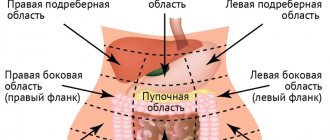Main causes of discharge
Discharge after medical termination of pregnancy is normal. The woman’s body cleanses the uterine cavity from fragments of the fertilized egg, accompanying the process with moderately heavy bleeding.
The causes of discharge are due to the following factors:
- detachment of the fertilized egg;
- intense contraction of the cervix;
- rupture of the vessels of the uterine cavity.
During an abortion, the mucous structures of the walls of the uterus, the outer layer and the endometrium are damaged. Bleeding can provoke sudden changes in a woman’s hormonal levels.
Normal discharge
After an abortion, the risk of infection always increases. Prolonged and heavy bleeding can easily contribute to the development of this process. It is important to monitor your own health and control the nature of your discharge.
An abortion can be considered successfully completed if after the termination the following phenomena are absent:
- prolonged heavy brown discharge;
- yellow color of discharge;
- bad smell;
- atypical impurities in blood clots.
On the first day after taking the abortifacient drug, embryonic development stops. On the second day it is rejected. The process of expulsion of the fertilized egg is accompanied by cramping pain, pulling sensations in the lower abdomen, and discharge with clots of bright red and scarlet hue.
Normal excretion is not accompanied by an unpleasant odor, heavy or scanty bleeding, and does not contain curdled components.
How to stop bleeding
When the patient has taken a drug to terminate the pregnancy, drugs to stop bleeding cannot be taken. The embryo can only come out with blood. If the bleeding is stopped, a purulent process will begin in the uterus, and everything will end in mechanical abortion (curettage). If the bleeding is very heavy, you should not wait for the situation to improve, call an ambulance, lie on your back and put a cold pack on your stomach.
See a gynecologist for 2-4 weeks after the abortion. Another examination is initiated after 1-2 months, in order to avoid inflammation of the reproductive system. Sometimes it is necessary to take a course of antibiotics and hemostatic agents, but not earlier than a week after terminating the pregnancy with drugs.
Duration of discharge
The duration of post-abortion excretion depends entirely on the individual characteristics of the body, the timing of the medical abortion, and compliance with all doctor’s recommendations. Bleeding usually continues for several weeks.
Many women note the persistence of light spotting bleeding for 30-40 days after an abortion. Bleeding may occur before your next period. The next period occurs on the 50th day after a medical abortion. Women may bleed differently. For some, everything ends within 12 days after the procedure.
Nature of the discharge
Important criteria for assessing the normal completion of a pharmaceutical abortion are the color and volume of blood excretion. With heavy or scanty bleeding, the help of specialists is often required to preserve the functionality of the woman’s reproductive system, her health, even saving her life.
Discharge color
The mechanism of expulsion of the fertilized egg is determined by the type of drug chosen.
Normal discharge is characterized by the following features and stages of appearance:
- red or scarlet color (the first 1-6 days after taking the pills);
- brown spotting (following days after the cessation of scarlet discharge).
Brown discharge after an abortion can persist for 10-12 days. This is due to the continued drainage of clotted blood. The color of the discharge varies from dark to black. Long-term secretion of dark brown mucus may suggest the presence of polyps in the uterus or the development of endometriosis. The condition is almost always associated with severe nagging pain in the lower abdomen and long-lasting dark (even black) discharge.
Yellow discharge characterizes the onset of the inflammatory process of the internal genital organs. The causative agents are staphylococci, E. coli, chlamydia, streptococci, trichomoniasis. Yellow discharge is often accompanied by an unpleasant smell of rotting. If atypical discharge occurs, it is important to sample the discharge from the cervical canal for pathogenic media.
As the uterus recovers, the discharge resembles a light pink ichor. For doctors, such symptoms are a signal of successful recovery of the body.
Discharge with pus is a sign of a sexually transmitted disease, inflammation of the ovaries, fallopian tubes of a bacterial nature. As a rule, a woman was infected before the termination of an unwanted pregnancy. Later infection occurs as a result of non-compliance with hygiene standards, unprotected sexual intercourse against the background of bleeding.
Pink discharge with mucus without an unpleasant odor, itching or irritation is normal and does not require special treatment.
Discharge of a large volume of mucus with an unpleasant odor, foam and a green tint indicates a fungal or bacterial disease of the internal genital organs.
A curd-like white discharge is characteristic of thrush caused by the Candida fungus. The disease has characteristic symptoms: burning, severe itching, pain during urination and sexual intercourse.
Discharge volume
Heavy discharge after an abortion is normal. Usually, all fragments of the fertilized egg, the dead epithelial layer at the site of attachment, leave the uterine cavity in the first 5 days after termination of pregnancy. Spotting brown discharge is not abundant, reminiscent of the last days of the active phase of the menstrual cycle.
The severity of post-abortion bleeding is influenced by a number of factors:
- characteristics of the body (age, weight, blood clotting ability, degree of muscle contractions of the uterus);
- gestational age (from the day of conception to 7 weeks with medical abortion);
- gynecological and general clinical history;
- compliance with the technique of the procedure (dosage, phased administration of funds).
Immediately after rejection of the fertilized egg, the discharge is slightly more intense than during normal menstruation. My health does not suffer. After 5-10 days, the bleeding decreases, the discharge is spotting. Heavy bleeding is indicated by the use of more than 3-4 pads of maximum absorbency per day (classical, urological).
Can an abortion fail?
This situation occurs extremely rarely - only in 1.6% of cases. Moreover, the earlier the interruption was carried out, the higher the likelihood that it will be successful.
It is almost impossible to determine by external signs whether a medical abortion has occurred, therefore, after the termination is completed, an ultrasound diagnosis is required to make sure that the fertilized egg has been completely released.
Unfortunately, it is impossible to create a pregnancy that is not terminated after taking the pills. Mifepristone and Misoprostol have a negative effect on the fetus and can lead to the development of severe congenital anomalies. Therefore, the pregnancy will have to be terminated in any case.
Additional symptoms
Vaginal discharge of normal color and volume is an indicator of a successful medical abortion. The main symptom, in addition to discharge from the cervical canal, is moderate pain.
When the following signs are added, pathology often develops:
- unpleasant odor (mostly sour or putrid);
- irritation of the mucous membranes of the external and internal genital organs;
- severe burning, itching;
- redness of the genital organs, swelling;
- inflammation extending to the inner thighs;
- curdled white-red discharge;
- foamy yellow discharge (a sign of an infectious disease).
To manifest the disease, it is important to use all methods of differential diagnosis (instrumental, laboratory methods). Atypical discharge is almost always a signal of a disorder of various origins.
What should you be wary of?
Medical abortion is performed only within the walls of a medical center under the supervision of specialists. This is necessary to prevent the first complications after an abortion: blood loss, lack of discharge, clouding of consciousness. Over the next few days, women need to monitor their own health condition and immediately consult a doctor if their health worsens.
No discharge
After any abortion in women, discharge is an indicator of a successful procedure. The absence of discharge from the cervical canal indicates stagnation of blood in the uterine cavity.
The main causes of blood retention are:
- malignant endometrial tumor;
- polyps, blood clots in the cervical lumen;
- spasm of the muscular structures of the cervix.
Blood retention in the uterus contributes to the development of the inflammatory process due to rotting of fragments of the fertilized egg and the remains of dead epithelium. Such conditions require immediate treatment and often lead to generalized sepsis, even death. One of the serious complications of a medical abortion without discharge is spasm of the uterine muscles and the development of hematometra. The disease is characterized by complete or partial disruption of blood outflow. Pathology is rarely detected in the early stages.
As the disease progresses, the symptoms increase:
- pain in the lower abdomen;
- menstrual irregularities:
- sudden cessation of discharge after abortion.
The main goal of therapy is to completely remove blood from the uterine cavity. In the presence of an inflammatory process, a course of antibacterial therapy is carried out.
Heavy bleeding
Intense bleeding is a complication of medical abortion when there is a direct threat to the woman’s life.
Excessive amounts of blood can occur for a number of reasons:
- simultaneous administration of a large dose of an abortifacient drug;
- incomplete abortion (preservation of fetal egg remnants in the uterine cavity);
- intense physical activity:
- hot bath, sauna, steam bath;
- visiting a solarium;
- frequent douching;
- traumatization;
- tamponing.
Unfortunately, complications can arise even if all medical recommendations are followed, which is due to the individual characteristics of the female body.
If heavy or absent discharge is accompanied by nausea, body temperature rises, episodes of vomiting, severe malaise, low blood pressure and unbearable pain occur, then these are direct signals for immediate treatment.
Author: Anna Levina, doctor specially for Mama66.ru
Abortion: Discharge after abortion is brown and bloody. What kind of discharge after an abortion is normal?
Today it is no secret to anyone that most women at least once in their lives undergo a procedure such as termination of pregnancy, either occurring naturally, or performed for medical reasons or due to reluctance to have a child. If you have had an abortion, post-abortion discharge is completely normal. We propose to talk about them in more detail in our article. Indeed, in some cases, they may indicate the penetration of a dangerous infection into the female body or a poorly performed termination of pregnancy.











